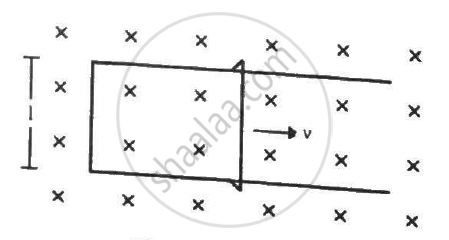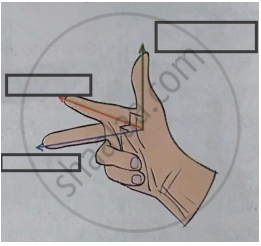Advertisements
Advertisements
प्रश्न
Figure shows a long U-shaped wire of width l placed in a perpendicular magnetic field B. A wire of length l is slid on the U-shaped wire with a constant velocity v towards right. The resistance of all the wires is r per unit length. At t = 0, the sliding wire is close to the left edge of the U-shaped wire. (a) Calculate the force needed to keep the sliding wire moving with a constant velocity v. (b) If the force needed just after t = 0 is F0, find the time at which the force needed will be F0/2.0

उत्तर
Emf induced in the circuit, e = Bvl
Current in the circuit,
\[i = \frac{e}{R} = \frac{Bvl}{2r(l + vt)}\]
(a) Force F needed to keep the sliding wire moving with a constant velocity v will be equal in magnitude to the magnetic force on it. The direction of force F will be along the direction of motion of the sliding wire.
Thus, the magnitude of force F is given by
\[F = ilB = \frac{Bvl}{2r(l + vt)} \times lB\]
\[ = \frac{B^2 l^2 v}{2r(l + vt)}\]
(b) The magnitude of force F at t = 0 is given by
\[F_0 = ilB = lB\left( \frac{lBv}{2rl} \right) \]
\[ = \frac{l B^2 v}{2r} .............(1)\]
Let at time t = T, the value of the force be F0/2.
Now,
\[\frac{F_0}{2} = \frac{l^2 B^2 v}{2r(l + vT)}\]
On substituting the value of F0 from (1), we get
\[\frac{l B^2 v}{4r} = \frac{l^2 B^2 v}{2r(l + vT)}\]
\[ \Rightarrow 2l = l + vT\]
\[ \Rightarrow T = \frac{l}{v}\]
APPEARS IN
संबंधित प्रश्न
Two circular coils A and B are placed closed to each other. If the current in the coil A is changed, will some current be induced in the coil B? Give reason.
A rectangular wire loop of sides 8 cm and 2 cm with a small cut is moving out of a region of uniform magnetic field of magnitude 0.3 T directed normal to the loop. What is the emf developed across the cut if the velocity of the loop is 1 cm s−1 in a direction normal to the
- longer side,
- shorter side of the loop?
For how long does the induced voltage last in each case?
When Puja, a student of 10th class, watched her mother washing clothes in the open, she observed coloured soap bubbles and was curious to know why the soap bubbles appear coloured. In the evening when her father, an engineer by profession, came home, she asked him this question. Her father explained to her the basic phenomenon of physics due to which the soap bubbles appear coloured.
(a) What according to you are the values displayed by Puja and her father?
(b) State the phenomenon of light involved in the formation of coloured soap bubbles.
Calculate the dimensions of (a) \[\int \overrightarrow{E} . d \overrightarrow{l,}\] (b) vBl and (c) \[\frac{d \Phi_B}{dt}.\] The symbols have their usual meaning.
A conducting square loop having edges of length 2.0 cm is rotated through 180° about a diagonal in 0.20 s. A magnetic field B exists in the region which is perpendicular to the loop in its initial position. If the average induced emf during the rotation is 20 mV, find the magnitude of the magnetic field.
The following diagram shows a fixed coil of several turns connected to a center zero galvanometer G and a magnet NS which can move in the direction shown in the diagram.
- Describe the observation in the galvanometer if
- The magnet is moved rapidly,
- The magnet is kept still after it has moved into the coil
- The magnet is then rapidly pulled out the coil.
- How would the observation in (i) of part (a) change if a more powerful magnet is used?

Fill in the blanks by writing (i) Only soft iron, (ii) Only steel, (iii) Both soft-iron and steel for the material of core and/or magnet.
A. C. generator______.
A transformer has 400 turns in the primary winding and 10 turns in the secondary winding. The primary e.m.f. is 250 V and the primary current is 2.0 A. calculate:
(a) The secondary voltage,
(b) The secondary current, assuming 100% efficiency.
List some of the practical applications of an electromagnet.
Using Ampere's law, obtain an expression for the magnetic induction near a current-carrying straight infinitely long wire.
Write the two names in the following diagram.
Fleming’s right hand rule.

Establish the fact that the relative motion between the coil and the magnet induces an emf in the coil of a closed circuit.
A closely wound circular coil of radius 0.02 m is placed perpendicular to the magnetic field. When the magnetic field is changed from 8000 T to 2000 T in 6 s, an emf of 44 V is induced in it. Calculate the number of turns in the coil.
A cylindrical bar magnet is kept along the axis of a circular coil. If the magnet is rotated about its axis, then ____________.
The condition for the praenomen of electromagnetic induction is that there must be a relative motion between ____________.
Ansari Sir was demonstrating an experiment in his class with the setup as shown in the figure below.

A magnet is attached to a spring. The magnet can go in and out of the stationary coil. He lifted the Magnet and released it to make it oscillate through the coil.
Based on your understanding of the phenomenon, answer the following question.
What will be observed when the Magnet starts oscillating through the coil. Explain the reason behind this observation.
Which of the following phenomena makes use of electromagnetic induction?
